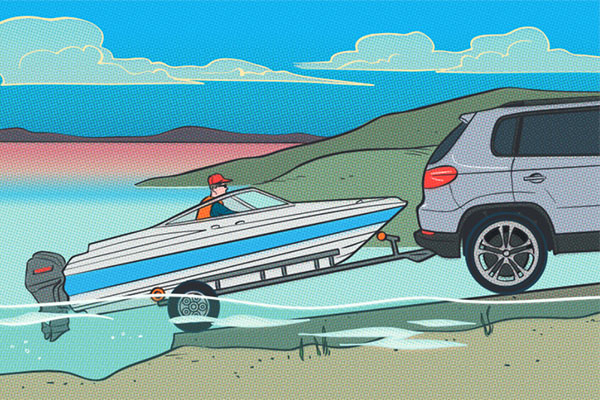There’s a reason that a search for “boat ramp fail” turns up thousands of videos: The ramp can be a tricky area.
But knowing how to properly perform boat retrieval is crucial for the care of your boat as well as the convenience of other drivers. Following a few precautions can help you safely load your watercraft.
Load It Up
Loading your boat onto a trailer starts with backing the trailer into the water. The tow vehicle’s wheels should almost reach the water’s edge, according to Ted Sensenbrenner, the BoatUS Foundation’s assistant director of boating safety programs. The trailer should be submerged, with the bunks and/or the rollers wet so that the boat can float up onto the trailer, he adds. Once your car is in position, put the emergency brake on, and place chocks behind the wheels to keep the vehicle secure.
Before you load the boat, BoatUS recommends off-loading any passengers at the dock—they can help direct the driver and guide the boat via the bow line. Once the trailer is in position, drive or float the boat so it’s centered on the trailer. (Some trailers offer guides to make this process easier.) But beware of power loading–it’s better to allow your boat to float lightly onto the trailer than it is to use lots of throttle and potentially scratch or otherwise damage your boat or erode the ramp.
To be in position, nest your trailered boat neatly so that the bunks and/or rollers support it evenly, to protect the bottom from the stress of bouncing down the road. Once the boat is centered and well supported, attach the bow winch strap or cable to the bow eye and winch it up until the bow reaches the winch post at the roller at the front end of the trailer, and then attach the emergency backup chain.
When the boat is connected, pull it up the ramp slowly to make sure it comes to rest evenly on the trailer. (If it’s not on straight, you may need to back down the ramp a little to adjust it.) Save all other checks for the parking lot, to give others room to get their boats out as well. “At the boat ramp, it should be as smooth as people getting in and out of an elevator,” Sensenbrenner says.
Get Road-Ready
Before you take your boat out on the road, make a few safety checks. First, take a walk around the trailer, Sensenbrenner says. Is the boat properly attached and tied down? Check that the coupler closes properly and isn’t rusty, and the safety chains are properly attached from the trailer to the tow vehicle. (They should be crossed to give your trailer plenty of maneuverability.) While you’re there, check the wiring connection and make sure the turn signals and brake lights illuminate properly. Larger trailers often come with brakes; make sure those are properly coupled as well.
Tires should be properly inflated with good tread, and grease should not be leaking from the bearings. “The number-one call to our dispatch center for trailer assistance has something to do with the tires,” Sensenbrenner says.
Drive to a safe place in the parking lot and finish up by removing the drain plug, attaching tie-downs, and removing anything from the boat that might blow away on the road. If you disconnected your trailer lights, plug them back in. Don’t forget to raise the sterndrive or outboard all the way up. Secure the boat cover if you have one, as well as the two transom tie-down straps at the back of the boat.
In general, the legal requirements for towing your boat safely vary slightly state to state, so it pays to check with your state’s Department of Transportation regulations to make sure all your bases are covered.
Keep your peace of mind on the water with boat insurance from GEICO and 24-hour dispatch towing service from TowBoatU.S.
By Nicole Price Fasig
Illustration by Remie Geoffroi










Leave a comment